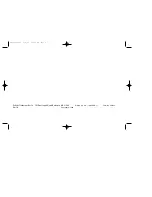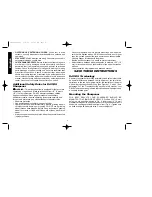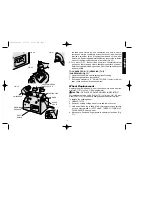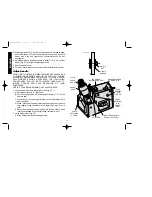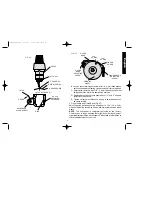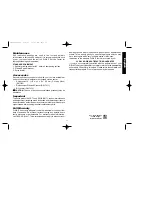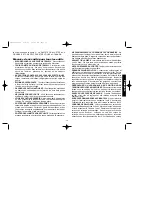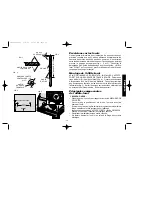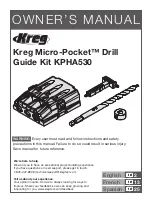
10
PROBLEM
1. Chisel angle too great—
greater than 135°
2. Chisel angle too small—
less than 120°
3. Bit will not drill
4. Discoloration (burning)
near cutting lips
5. Flats or chatter marks
on ground surfaces
6. Large variation in lip height
(point off center)
7. Swinghead will not stay
locked in sharpening or
dressing position
8. Hard to pivot swinghead
back and forth
9. Bent locator
10. Unit getting unusually hot
English
Troubleshooting
REMEDY
Bit was not ground close enough to
locator or was positioned incorrectly, See
Step 6 under “Preparing to sharpen.”
Edge of locator was not flat against flute.
See step 6 under “Preparing to sharpen.”
Or bit was ground too close to locator.
Insufficient relief angle. See Step 6
under “Preparing to sharpen,” for proper
positioning of bit.
Material is being removed too fast. Slow
down feed rate.
A. Looseness in pivot rod bearing
system—see adjustments
B. Wheel needs dressing
C. Feed at slower rate
D. Slow down speed of rocking motion
A. Bent bit
B. Looseness in pivot rod bearings—
follow adjustments
C. Unequal hand pressure on
swinghead while sharpening
Latch set screw needs adjustment.
Gib screws adjusted too tight.
Place a 1/8" (3 mm) bit in chuck and
bend locator until the tip is directly over
bit center or replace locator.
Check motor air intake and exhaust
openings on bottom of tool for blockage.
4. The Locator (Fig. 28)
The locator on the chuck of your drill bit sharpener has been
inspected at the factory for proper positioning and assembly. Should
the locator edge become damaged for any reason while grinding
during the initial learning operation of the tool, it is easily replaced
with the extra locator provided.
CAUTION: Tighten screws just enough to seat locator against
chuck. DO NOT OVERTIGHTEN
FIG. 28
CHUCK
LOCATOR
SCREWS
DW751/385103 5/2/02 12:51 PM Page 10

